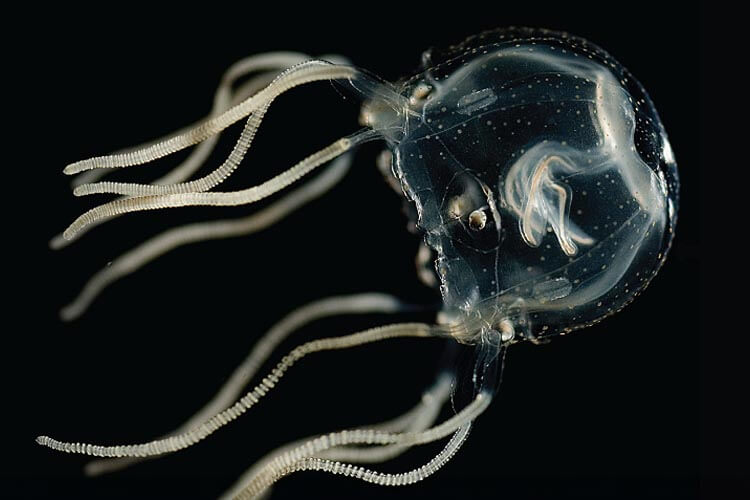
Jellyfish don’t have a reputation for being deep-thinking creatures. In fact, most people probably assume that they don’t have a brain at all. In most respects, this is true. Jellyfish don’t have a central brain but, as scientists have recently discovered, jellyfish can learn through association
Floating through the warm brackish waters of mangrove forests, the Caribbean box jellyfish (Tripedalia cystophora) is a tiny, almost completely translucent, and apparently very simple creature. Yet looks can be deceiving. By their very nature mangrove swamps, with their network of tangled root systems and ever-changing water levels, are complicated environments to navigate.
Yet somehow the box jellyfish manages to avoid getting snagged on underwater obstacles. How does it achieve this seemingly impossible task? For a start, this jellyfish has eyes (a number of jellyfish species have eyes though in many cases these are more ‘eye spots’ that simply detect light) and not just two eyes like us. This jellyfish goes all out and has 24 eyes which help it navigate the often-murky mangrove waters.
But it seems that box jellyfish can’t just see where they’re going but, as reported in the September edition of the journal Current Biology, scientists have discovered that box jellyfish are also able to learn from past mistakes through associative learning.
You may also like:

To come to this conclusion scientists placed some jellyfish in a circular aquarium that had been decorated with white and grey or black stripes. The grey and black stripes represented distant mangrove roots which the jellyfish were supposed to avoid.
At first, the jellies repeatedly swam too close to the mangrove ‘roots’ and crashed into them. But then, after just seven and a half minutes, the scientists noted that the jellyfish kept around 50 per cent further away from the aquarium walls than at the start of the experiment, and that they quadrupled the number of pivots they made in order to avoid hitting the grey stripes.
Impressive stuff, but report co-author, Jan Bielecki, from the Kiel University in Germany, wanted to know more about how the jellyfish were learning to change their behaviour.
The eyes on a box jellyfish aren’t eyes like we have. Instead, they’re called rhopalia, which are best described as eye-brain complexes. Each of these rhopalia contains six very basic eyes as well as nerve centres, which are called pacemakers. Together these control the movements of the jellyfish.
Bielecki removed one of these rhopalia from an unfortunate jellyfish and set it up facing a screen with grey bars moving across it. To mimic a collision with a grey bar, a very mild electric shock was given to the rhopalia. By recording the electrical activity in the nerves of the rhopalia, Bielecki discovered that after just five minutes in front of the screen, there was an increase in nerve activity within the pacemakers every time a grey bar was shown moving across the screen. Essentially the bodiless rhopalia was trying to swim away from the mangrove root.
And it seems that jellyfish aren’t the only surprising creatures to have the ability to learn from associative learning. Certain species of sea anemones have also been shown to have a similar skill. So, while it’s unlikely that jellyfish and sea anemones will ever sit down to discuss philosophy together, we do now know that these animals aren’t mere brainless blobs of jelly.
- Half of all mangrove forests at risk of collapse - 14 July 2024
- Fibreglass particles discovered in oysters and mussels - 4 July 2024
- Grey whales in the northeastern Pacific are shrinking - 19 June 2024


